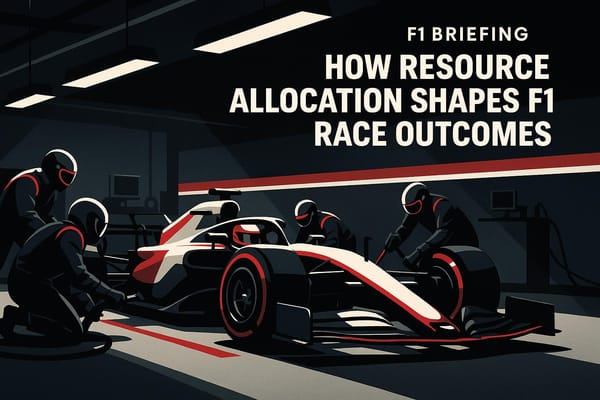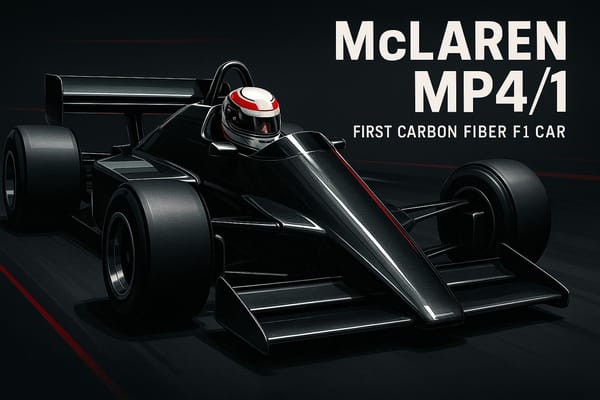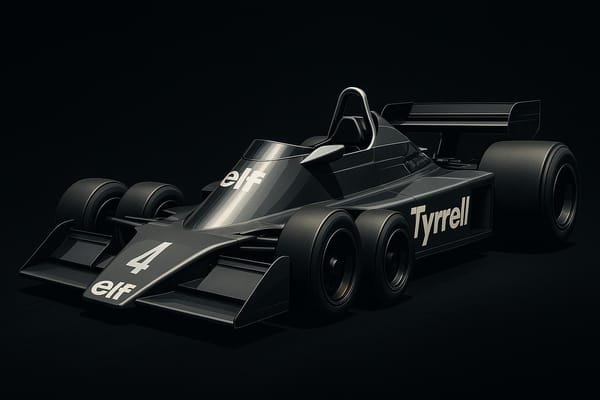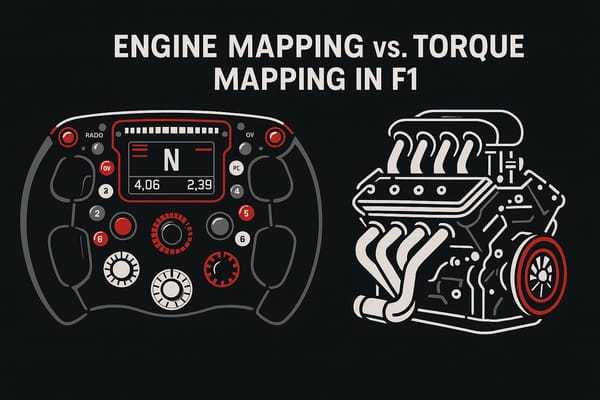How DRS Works in F1 Overtakes
Explore how DRS enhances overtaking in F1, its mechanics, activation rules, team strategies, and future regulations aimed at improving racing dynamics.

DRS (Drag Reduction System) is a tool that helps F1 drivers overtake by reducing drag on straights, giving them a speed boost. Here's how it works and why it matters:
- What It Does: DRS opens a flap on the rear wing to reduce drag, increasing speed by 6–7.5 mph (10–12 km/h) in activation zones.
- When It’s Used: Drivers can activate DRS when they are within 1 second of the car ahead, but only in designated zones and under specific race conditions.
- Why It Matters: It helps drivers counter “dirty air” from the car ahead, making overtakes easier and races more exciting.
- Key Rules: DRS is disabled in the first two laps, after safety car restarts, or in unsafe conditions like rain. The system is also strictly regulated for safety and fairness.
- 2025 Updates: Stricter technical rules now limit DRS to fully open or closed positions, with tighter testing on rear wing gaps.
While DRS has made overtaking more common (adding about 10 overtakes per race), critics argue it feels "artificial." Future F1 regulations in 2026 aim to replace DRS with active aerodynamics for more natural overtaking.
Keep reading to learn how DRS works mechanically, its activation rules, and how teams use it strategically during races.
INVISIBLE FORCE: How DRS Makes or Breaks F1 Races (2025 Guide)
How DRS Works Mechanically
The Drag Reduction System (DRS) is a marvel of engineering that simplifies overtaking in Formula One. At its heart, it transforms the rear wing from a downforce-generating feature into a tool for reducing drag - all at the push of a button. Let’s break down how the system works, focusing on the rear wing mechanism and how drivers control it during a race.
The Rear Wing Mechanism
The rear wing on an F1 car is carefully designed to use aerodynamic forces to create downforce. When air flows over the curved surface of the wing, it speeds up underneath, creating low pressure, while the higher pressure above pushes the car downward. This added grip is crucial for maintaining control through corners. However, when DRS is engaged, the dynamic changes completely. A hydraulic actuator shifts a movable flap from its standard, closed position to an open, horizontal one. This adjustment creates a gap that allows air to flow through the wing, drastically reducing drag and downforce. According to regulations, the gap can open up to 3.3 inches (85 millimeters).
A great example of DRS effectiveness came in 2022, when Red Bull Racing's system gave Max Verstappen a top-speed boost of 20 mph during an overtaking move. This shows just how powerful the system can be when executed well.
Driver Control and Activation
The mechanical setup of the rear wing is only part of the equation - driver input is equally critical. Drivers activate DRS by pressing a button on their steering wheel, which is custom-positioned based on their individual preferences. Once pressed, the hydraulic actuator immediately opens the rear wing flap, and dashboard lights confirm the system is engaged. DRS deactivates as soon as the driver releases the button or applies the brakes, with the flap automatically closing the moment braking begins.
Behind the scenes, advanced sensors ensure everything operates with pinpoint accuracy. For instance, Gill Sensors developed a specialized non-contact position sensor for an F1 team. This compact device, mounted within the rear wing end plates, tracks the flap’s position in real time without disrupting aerodynamics. It provides a precise 0–4.5V analog output with an accuracy of 0.1°. Additionally, the car’s electronics monitor whether the driver is within one second of the car ahead - a key condition for DRS activation.
The importance of precision in these systems cannot be overstated. In 2021, Lewis Hamilton’s car was disqualified in Brazil because the DRS flap exceeded the 85 mm gap limit during activation. Such strict controls not only ensure compliance with regulations but also play a decisive role in shaping overtaking strategies during races.
DRS Activation Rules and Zones
Understanding how and when to activate DRS (Drag Reduction System) is a crucial part of overtaking in Formula 1. The system operates under strict guidelines, with specific timing and location rules that add a layer of strategy for teams aiming to gain an edge on the track.
Detection and Activation Points
DRS relies on electronic timing loops placed at specific points on the circuit. These loops measure the gap between cars, and if a driver is within one second of the car ahead when crossing a detection point, the system sends a signal to the car. This signal illuminates a light on the dashboard, letting the driver know that DRS is available to use.
This rule applies to all race scenarios, including lapped traffic. Teams often notify drivers when an opponent is closing the gap to within DRS range. Additionally, the FIA has the flexibility to adjust the one-second gap threshold between races to accommodate varying track characteristics and conditions.
However, DRS has its restrictions. Drivers cannot activate it during the first two laps of a race or immediately following a restart after a safety car or red flag. The FIA race director also has the authority to disable DRS entirely if conditions are deemed unsafe, such as during rain or when there is debris or an incident on the track.
These rules are carefully designed to ensure the system is used strategically and safely, with each circuit featuring tailored DRS zones.
DRS Zones Across Circuits
The placement of DRS zones is a collaborative effort between circuit designers and the FIA, aimed at maximizing overtaking opportunities. Most tracks include two DRS zones, but the number can vary depending on the circuit’s layout. These zones are typically located on long straights, where the aerodynamic advantage of DRS can have the most impact.
For circuits where overtaking is notoriously difficult, additional DRS zones may be added to improve the racing experience. Take the 2025 Miami Grand Prix, for example: it features three DRS zones. The first zone starts 295 feet (90 meters) after Turn 18, the second begins 230 feet (70 meters) after Turn 16, and the third detection point is just 49 feet (15 meters) after Turn 17.
To help drivers time their activation, visual markers are placed on the track. These include lines indicating detection and activation points and vertical "DRS" signs marking the start of each zone.
Current Regulations and Restrictions
Recent updates to DRS regulations have introduced stricter technical requirements. Building on existing activation rules and zone designs, the 2025 season now mandates that DRS can only operate in fully open or fully closed positions, eliminating the possibility of partial activation, sometimes called "mini-DRS".
Technical testing has also become more demanding. The force applied during rear wing slot gap deflection tests has increased from 10 newtons (approximately 2.25 pounds-force) to 30 newtons (approximately 6.75 pounds-force). The slot gap is now restricted to a range of 9.4–13 mm, while the maximum open gap remains capped at 85 mm. Additionally, the time it takes for DRS to transition between positions is now limited to under 400 milliseconds.
Traditional race restrictions remain in place as well. For example, drivers can only use DRS when they are within one second of a car ahead, ensuring it remains an overtaking tool rather than a defensive mechanism. According to FIA estimates, DRS can boost a car’s speed by 10–12 km/h (6.2–7.5 mph) by the end of the activation zone, with reduced aerodynamic drag allowing for a higher top speed over approximately 15 kilometers (9.3 miles).
These detailed regulations ensure that DRS continues to enhance overtaking opportunities while maintaining fairness, safety, and competitive integrity across all Formula 1 circuits.
How Teams Use DRS in Races
Building on the mechanical and regulatory groundwork, teams employ detailed strategies to make the most of DRS during races. The coordination between drivers, race engineers, and strategists is crucial to balancing short-term overtaking opportunities with long-term race positioning.
Overtaking Methods with DRS
Timing is everything when it comes to DRS activation. Teams rely heavily on real-time data and simulations to decide the perfect moment to deploy it. Race engineers monitor a variety of factors - like gaps between cars, track position, and tire conditions - to ensure drivers get the most out of the aerodynamic edge DRS provides.
The speed difference DRS can create is often game-changing. A standout example occurred during the 2023 Australian Grand Prix when Verstappen used DRS to achieve an 11 mph (17 km/h) speed advantage over Hamilton, overtaking him for the lead. While Hamilton maxed out at 185 mph (298 km/h), Verstappen surged ahead, hitting 202 mph (325 km/h).
DRS also plays a role in tire management strategies. Drivers may conserve tire wear during certain race phases, planning to use DRS for critical overtakes later on. Some racing directors suggest that efficient DRS use can shave up to half a second off lap times.
Its impact on race dynamics is undeniable. Over the past five seasons, Formula 1 races have seen an average of 10 more overtakes per event, thanks to improved DRS strategies. Teams position drivers strategically within DRS zones to maximize overtaking chances while keeping an eye on overall race positioning.
Engineers are pivotal during the race, providing drivers with real-time updates about the gaps to cars ahead and behind. While DRS is a powerful tool for overtaking, teams also develop tactics to counter its effects when they’re on the defensive.
Defense and Counter-DRS Tactics
While DRS is a potent offensive tool, teams have crafted strategies to defend against it effectively. One key tactic involves using hybrid energy systems for an extra burst of speed. Drivers can activate an "overtake" or "SoC" button to accelerate quickly onto a straight, making it harder for a DRS-enabled car to pass. Timing and energy management are critical for this maneuver.
The concept of "DRS trains" adds another layer of complexity. When multiple cars are within one second of each other, defending drivers can also activate DRS, neutralizing the attacker’s advantage since both cars benefit from reduced drag. Teams closely monitor these formations, advising drivers on whether to break away or use the train defensively.
Track positioning is another essential element of defense. Engineers alert drivers when the car behind is cleared for DRS activation, allowing them to adjust their defensive approach. Skilled drivers can block overtaking attempts by lingering at the apex of a corner, disrupting the attacker’s preferred racing line. Others apply psychological pressure by staying close to the car ahead, experimenting with different lines to provoke a mistake.
The effectiveness of these defensive tactics often depends on the circuit. Teams analyze track layouts in detail to identify DRS zones that pose the most significant risks and develop tailored defensive strategies for each race. Modern F1 defense is no longer about simple blocking; it’s a complex game involving DRS management, hybrid energy use, tire conservation, and fuel strategy. This multifaceted approach makes defending against overtakes more unpredictable and strategic than ever.
Impact and Evolution of DRS in F1
Since its debut in 2011, DRS (Drag Reduction System) has brought a significant shift to Formula One racing. Designed to tackle the "dirty air" issue that hindered overtaking, DRS has become a key feature of the sport. However, its impact has sparked ongoing debates about its role in racing dynamics and fairness. Over the years, it has shaped both performance metrics and conversations about the future of F1.
Performance Gains from DRS
The speed boost provided by DRS depends on the circuit and the car's setup. According to the FIA, DRS typically adds about 6–7.5 mph (10–12 km/h) by the end of activation zones, though some estimates suggest a smaller gain of 2.5–3.1 mph (4–5 km/h). At the 2023 Qatar Grand Prix, Aston Martin recorded an impressive 17 mph (28 km/h) advantage with DRS. These performance boosts have reshaped driver strategies, with DRS zones becoming a critical part of race planning.
Controversies Around DRS
While DRS has succeeded in making overtaking easier, it’s also one of the sport’s most debated features. Critics argue that it oversimplifies overtaking, taking away the skill and strategy traditionally associated with passing. The main complaint centers on fairness - DRS gives the chasing driver an edge while the leading car has no equivalent defensive option. Many fans and drivers feel that DRS-assisted overtakes lack the excitement and satisfaction of traditional moves based purely on racecraft.
Physics expert Albert Germaine described DRS as:
"A contrived solution that works quite well"
Similarly, Ernesto Gasulla called it:
"The least bad band aid that could be used to overcome modern aerodynamics"
Another criticism is the predictability of DRS passes. Once activated, overtakes can feel inevitable, reducing the suspense that makes racing thrilling. Some argue that Formula One has become too dependent on DRS, with overtaking sometimes appearing more mechanical than skillful.
Future of DRS and 2025 Regulation Changes
In response to these critiques, Formula One is working to reduce its reliance on DRS. Jason Somerville, the FIA’s head of aerodynamics, expressed this goal clearly:
"We'd very much like to phase out DRS if we can"
For the 2025 season, new regulations aim to address fairness and limit exploitation of the system. The FIA has tightened rules for rear wings, restricting DRS to two positions - fully open or fully closed. Changes include stricter testing of rear wing slot gaps and new deflection limits to eliminate "mini-DRS" designs. The allowable slot gap has been reduced to 9.4–13 mm, and the transition between positions must now occur in under 400 milliseconds.
Nikolas Tombazis, FIA Single Seater Director, explained the motivation behind these updates:
"When championship battles become intense, teams tend to focus on each other's cars a lot, and naturally they raise concerns and over the latter half of the season we came to the conclusion that we needed to toughen a bit more the tests for 2025"
Looking further ahead, the 2026 regulations will introduce active aerodynamic systems to replace traditional DRS. These systems will allow both front and rear wings to adjust automatically, helping drivers close gaps more naturally. Drivers within one second of the car ahead will also receive a boost in battery power to assist with overtaking, potentially making DRS obsolete.
Pat Symonds, Formula 1's chief technical officer, highlighted the progress made with the 2022 car designs:
"We set certain objectives when we did the '22 car, one of them was for the cars to be able to follow each other closely. And we certainly achieved that, we achieved it, actually, probably better than I ever expected we would do"
The move toward active aerodynamics reflects F1's ongoing efforts to create a balance between competitive racing and authentic overtaking, ensuring the sport remains both exciting and skill-driven as it evolves.
Conclusion
Since 2011, the Drag Reduction System (DRS) has reshaped Formula 1 racing by making overtaking more achievable while maintaining the sport's competitive balance. The system works by opening a rear wing flap to create an 85-mm gap, which reduces aerodynamic drag and increases speed by about 6–7 mph (10–12 km/h).
Drivers need to master the art of timing and positioning within the designated DRS detection zones to make the most of this tool. Meanwhile, teams incorporate DRS into their overall race strategies, particularly when planning defensive moves, leading to more aggressive on-track battles.
Although some critics argue that DRS feels artificial, its importance in modern F1 is undeniable. As Charles Leclerc noted:
"I think without DRS passing would be reduced significantly. So I think we are still better off with DRS"
Statistics back this up - Formula 1 has seen an average of 10 more overtakes per race over the last five seasons since DRS was introduced in 2011. These discussions highlight the ongoing evolution of the sport's regulations.
Looking to the future, F1 is preparing for a major technological shift. Starting in 2026, the sport will replace DRS with active aerodynamics. This system will allow all drivers to toggle between high downforce and low drag modes, regardless of the gap to the car ahead. As Jason Somerville, the FIA's head of aerodynamics, explained:
"With the 2026 car we'll be giving the drivers the ability to switch between the high downforce and low drag modes irrespective of any gaps"
FAQs
What is DRS in Formula 1, and how does it help with overtaking?
The Drag Reduction System (DRS) is a game-changing feature in Formula 1 that helps drivers overtake more effectively, adding an extra layer of excitement to the races. It operates by opening a flap on the rear wing of the car, which reduces aerodynamic drag. This adjustment allows the car to achieve greater speeds on straight sections of the track.
However, DRS isn’t something drivers can use freely. It’s only activated in designated DRS zones and comes with specific conditions - like being within one second of the car ahead. Since its introduction in 2011, DRS has transformed the sport by creating more overtaking opportunities, injecting a sense of unpredictability into the races. It has become a crucial part of F1 strategy, keeping fans and teams on the edge of their seats.
What are the rules for using DRS during an F1 race?
The Drag Reduction System (DRS) comes into play under certain conditions during a race:
- The chasing car must be within 1 second of the car ahead at a designated DRS detection point.
- DRS is off-limits during the first two laps of the race or right after a safety car period.
- It can only be activated in specific DRS zones on the track.
- Drivers must manually engage DRS by pressing a button on their steering wheel.
These guidelines are designed to make overtaking more strategic and thrilling, while keeping the competition fair.
How will active aerodynamics in 2026 change the way overtaking works in Formula 1?
Starting in 2026, Formula 1 is set to introduce active aerodynamics, a major shift from the current Drag Reduction System (DRS). This advanced system will let drivers adjust the angles of their front and rear wings in real time, helping to cut drag while still maintaining crucial downforce. Unlike DRS, which can only be activated in designated zones, active aerodynamics will be available throughout the entire race, offering consistent performance improvements on straights and through corners.
This change is expected to make overtaking feel more natural and happen more often. By improving aerodynamic efficiency and giving drivers more flexibility, the system moves away from the reliance on specific DRS zones, paving the way for a more exciting and competitive racing experience for both drivers and fans.




